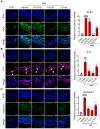A Novel HDAC6 Inhibitor Ameliorates Imiquimod-Induced Psoriasis-Like Inflammation in Mice
- PMID: 40807399
- PMCID: PMC12348054
- DOI: 10.3390/molecules30153224
A Novel HDAC6 Inhibitor Ameliorates Imiquimod-Induced Psoriasis-Like Inflammation in Mice
Abstract
Psoriasis is a chronic inflammatory skin disease characterized by abnormal proliferation of keratinocytes and infiltration of inflammatory cells. Significant challenges remain in developing effective and safe targeted therapies for psoriasis. Here, we reported the discovery of novel cystamine derivatives for the treatment of psoriasis. These compounds effectively attenuated LPS-induced inflammation in vitro, and the optimal candidate CS1 ameliorated imiquimod-induced psoriasis-like inflammation in mice. Mechanistically, CS1 bound and inhibited the deacetylase HDAC6, subsequently inhibited the AKT, MAPK, and STAT3 pathways, attenuated the hyperproliferation and altered differentiation of keratinocytes and reduced the infiltration of immune cells. These findings suggest that HDAC6 may serve as a potential target for drug development in the treatment of psoriasis.
Keywords: HDAC6; MAPK; STAT3; inflammation; psoriasis.
Conflict of interest statement
Authors Y. Feng is employed by Inno Biopharmaceuticals (Shenzhen) Co., Ltd. The remaining authors declare that this research was conducted in the absence of any commercial or financial relationships that could be construed as a potential conflict of interest.
Figures







Similar articles
-
Enhanced BEST2 expression in keratinocytes alleviates psoriatic inflammation.Int Immunopharmacol. 2025 Aug 28;161:115077. doi: 10.1016/j.intimp.2025.115077. Epub 2025 Jun 17. Int Immunopharmacol. 2025. PMID: 40532325
-
Gentiopicroside ameliorates psoriasis-like skin lesions in mice via regulating the Keap1-Nrf2 pathway and inhibiting keratinocyte activation.Acta Pharmacol Sin. 2025 May;46(5):1361-1374. doi: 10.1038/s41401-024-01449-8. Epub 2025 Jan 8. Acta Pharmacol Sin. 2025. PMID: 39779965
-
Benzoylpaeoniflorin alleviates psoriasis-like inflammation by modulating immune balance and inhibiting NF-κB signaling pathway.Bioorg Chem. 2025 Aug;163:108711. doi: 10.1016/j.bioorg.2025.108711. Epub 2025 Jun 27. Bioorg Chem. 2025. PMID: 40609281
-
Animal models of psoriasis for novel drug discovery: a literature update.Expert Opin Drug Discov. 2025 Sep;20(9):1193-1208. doi: 10.1080/17460441.2025.2528959. Epub 2025 Jul 9. Expert Opin Drug Discov. 2025. PMID: 40629854 Review.
-
The role of HDAC6 in fibrosis: a novel and effective therapy strategy.Eur J Med Res. 2025 Jul 4;30(1):571. doi: 10.1186/s40001-025-02840-9. Eur J Med Res. 2025. PMID: 40615924 Free PMC article. Review.
References
MeSH terms
Substances
LinkOut - more resources
Full Text Sources
Medical
Miscellaneous

